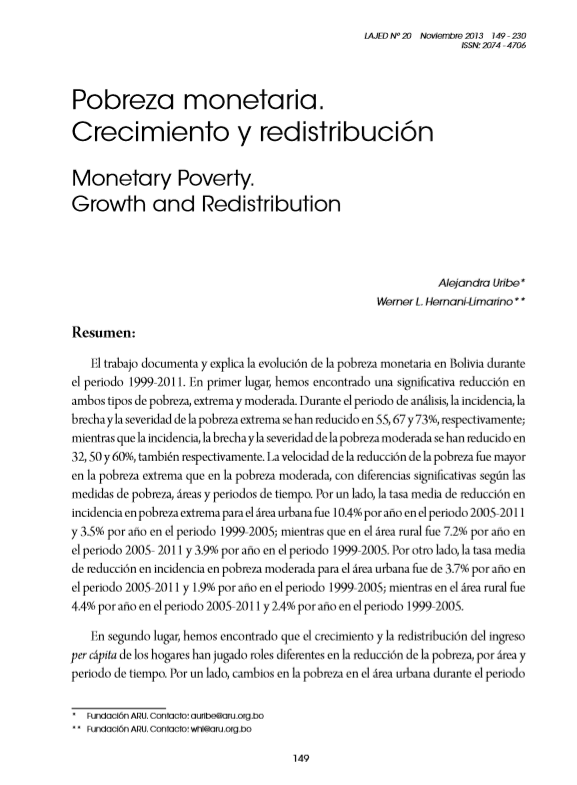Monetary Poverty. Growth and Redistribution
DOI:
https://doi.org/10.35319/lajed.201320104Keywords:
Poverty, growth, redistributionAbstract
This paper documents and explains the evolution of monetary poverty in Bolivia during the period 1999-2011. First, we find a significant reduction in both, extreme and moderate, poverty. During the period under analysis, extreme poverty headcount, gap and severity have reduced in 55, 67 and 73%; while moderate poverty headcount, gap and severity have reduced in 32, 50 and 60%, respectively. The speed of poverty reduction was greater in extreme poverty than in moderate poverty, with significant differences by poverty measures, areas, and time periods. On the one hand, the average reduction rate in extreme poverty headcount in urban areas was 10.4% per year in the 2005-2011 period and 3.5% per year in the 1999-2005 period; while in rural areas was 7.2% per year in the 2005- 2011 period and 3.9% per year in the 1999- 2005 period. On the other hand, the average reduction rate in moderate poverty headcount in urban areas was 3.7% per year in the 2005-2011 period and 1.9% per year in the 1999-2005 period; while in rural areas was 4.4% per year in the 2005-2011 period and 2.4% per year in the 1999-2005 period. Second, we find that growth of and redistribution in per capita household income have played different roles in poverty reductions by are and time period. On the one hand, poverty changes in urban areas during the 1999-2005 period are mainly explained by the growth in per capita income -which was enough to compensate for the increase on income inequality; while poverty changes during the 2005-2011 period was the result of both, growth in and redistribution of per capita income. On the other hand, poverty reductions in rural areas are mainly explained by the sustained growth of per capita household income, more intense during the last than during the first period.
Downloads
References
Altimir, O. (1979). “La dimensión de la pobreza en América Latina”. Cuadernos de la CEPAL, vol. 27.
Apablaza, M., Ocampo, J. P. y Yalonetzky, G. (2010). Descomposición de cambios en la pobreza multidimensional en diez países.
Arauco, V. P., Molina, G. G., Pozo, W. J. y Alguilar, E. Y. (2013). Explaining Low Redistributive Impact in Bolivia. CEQ, Working Paper Nº6.
Atkinson, A. B. (1970). “On the Measurement of Inequality”. Journal of Economic Theory, 2, 244-263.
Bruno, M., Ravallion, M. y Squire, L. (1998). “Equity and Growth in Developing Countries: Old and New Perspectives on the Policy Issues”. En: En: V. Tanzi y K. Chu: Income Distribution and High-quality Growth, 117–146. MIT Press, Cambridge, MA
Eid, A., Hernani-Limarino, W. y Aguirre, R. (2013). “Trends in income and consumption inequality in Bolivia: A fairy tale of growing dwarfs and shrinking giants” Draft – Public disclosure unauthorized 2. The Bolivian inequality decline in the literature: International trend aggregation and local lack of i.
Foster, J. Greer, J. y Thorbecke, E. (1984). “A class of decomposable poverty measures”. Econometrica, Journal of the Econometric Society, 52 (3), 761–766.
---------- (2010). “The Foster–Greer–Thorbecke (FGT) P overty Measures: 25 years later”. The Journal of Economic Inequality, 8 (4), 491–524.
Grosse, M., Klasen, S. y Spatz, J. (2005). Creating National Poverty Profiles and G rowth Incidence Curves with Incomplete Income or Consumption E xpenditure Data: An Application to Bolivia. Tech. rep., Discussion papers//Ibero America Institute for Economic Research.
Jiménez, W. y Lizárraga, S. (2003). “Ingresos y desigualdad en el área rural de Bolivia”. UDAPE, La Paz, Bolivia.
Kakwani, N. (1980). “On a class of poverty measures”. Econometrica, 48 (2): 437–446.
Landa, F. (2004). “Las dotaciones de la población ocupada son la fuente que explica la desigualdad de ingresos en Bolivia”. Revista de Análisis Económico, Nº 19.
Meier, G. M. (1964). Leading Issues in Development Economics. New York: Oxford Univ. Press.
Mena, G. y Hernani, W. (2013). Construcción del agregado de ingreso y consumo en Bolivia.
---------- (2013). Trends in Income and Consumption Inequality in Bolivia. A fairy tale of growing dwarfs and shrinking giants.
Mena, G., Jiménez, W. y Hernani, W. (2013). “La canasta básica de alimentos y líneas de pobreza en Bolivia para el periodo 1999-2012”.
Myles, J. y Picot, G. (2000). “Poverty Indices and Policy A nalysis”. Review of Income and Wealth, 46 (2), 161–179.
Pereira, R. y Velasco, T. A. (1993) “Estimación de la pobreza urbana en Bolivia”, Serie Documentos de trabajo, Nº/93, UDAPSO, La Paz , Bolivia.
Ravallion, M. (1992). “Poverty Comparisons. A Guide to Concepts and Methods”. World Bank. Living Standards Measurement Study Working Paper (88).
---------- (2004). Pro-poor Growth: A primer. World Bank Policy Research. Working P aper (3242).
Ravallion, M. y Chen, S. (2003). “Measuring pro-poor growth”. Economics letters, 78 (1), 93–99.
Sastre, M. y Trannoy, A. (2002). “Shapleyinequality decomposition by factor components: Some methodological issues”. Journal of Economics, 9 (1), 51–89.
Sen, A. ( 1976). “Poverty: an Ordinal Approach to Measurement”. Econometrica: Journal of the Econometric Society, 44 (2), 219–231.
Sucujayo, L. Dinámica de la pobreza y el crecimiento económico en Bolivia.
White, H. y Anderson, E. (2001). Growth versus Distribution: does the pattern of growth matter?” Development Policy Review, 19 (3), 267–289.






